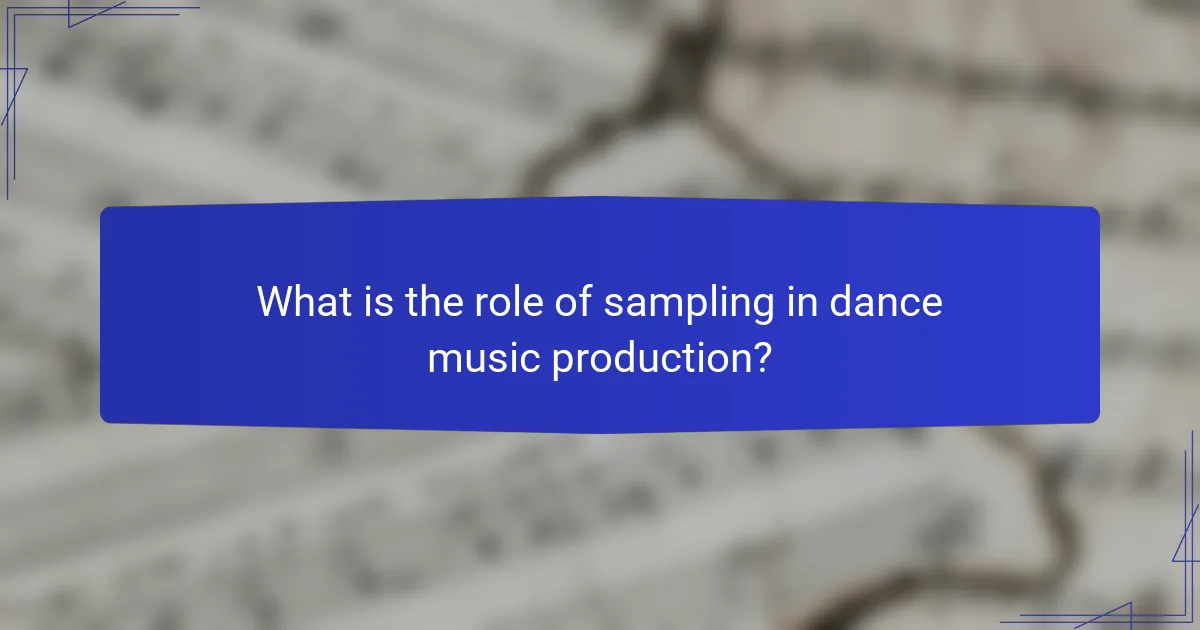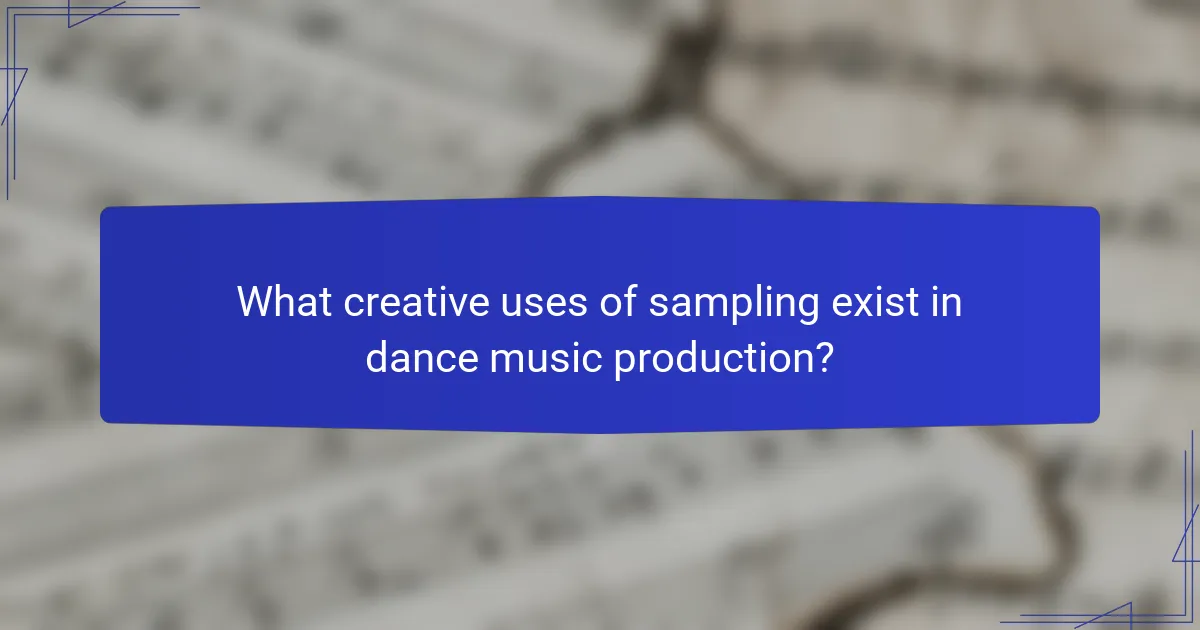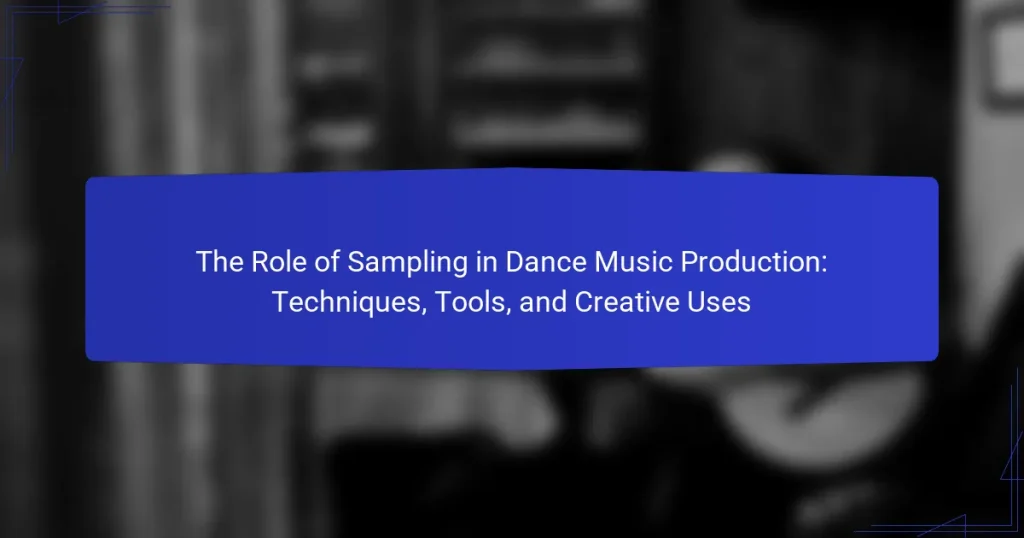Sampling is a fundamental technique in dance music production, involving the use of segments from existing audio recordings to create new compositions. This article explores the significance of sampling, its historical impact on genres like house and techno, and the essential tools needed for effective sampling, including Digital Audio Workstations (DAWs) and sampler software. It also highlights creative applications of sampling, such as developing unique sound textures, remixing tracks, and enhancing live performances. By examining the diverse uses of sampling, the article illustrates its role in fostering innovation and bridging musical influences within dance music.

What is the role of sampling in dance music production?
Sampling plays a crucial role in dance music production. It involves taking segments of existing audio recordings to create new compositions. Producers use samples to add texture and depth to their tracks. This technique allows for the incorporation of diverse sounds and influences. Sampling can also enhance creativity by enabling unique combinations of different musical elements. Historically, sampling has shaped various genres within dance music, including house and techno. Notable examples include the use of drum breaks and vocal snippets. The innovative use of sampling has transformed the landscape of modern music production.
How does sampling influence the creative process in music production?
Sampling significantly influences the creative process in music production by providing new sounds and inspiration. Producers often use samples to create unique compositions. This technique allows for the incorporation of diverse musical elements. Sampling can evoke nostalgia or introduce innovative textures. It also encourages experimentation with rhythm and melody. Notably, artists like The Avalanches and DJ Shadow have built entire albums around sampling. The practice fosters collaboration across genres and eras. Ultimately, sampling enriches the creative palette available to music producers.
What are the historical origins of sampling in dance music?
Sampling in dance music originated in the late 1960s and early 1970s. It began with the use of tape loops and reel-to-reel machines. Artists like Brian Eno and Kraftwerk experimented with these technologies. The introduction of the Fairlight CMI in the late 1970s revolutionized sampling. This digital sampler allowed musicians to manipulate sound recordings easily. By the 1980s, hip-hop artists popularized sampling, influencing dance music. Tracks like “Planet Rock” by Afrika Bambaataa showcased its potential. The practice became mainstream in the 1990s with the rise of electronic dance music genres. Sampling has since evolved with software and digital tools, shaping contemporary dance music production.
How has sampling evolved with technology in music production?
Sampling in music production has evolved significantly with advancements in technology. Initially, sampling involved physical hardware like samplers and vinyl records. These devices limited the quality and duration of samples due to storage constraints. The introduction of digital audio workstations (DAWs) revolutionized sampling, allowing for higher quality recordings and longer sample lengths. Software samplers emerged, enabling producers to manipulate samples with greater flexibility.
The rise of MIDI technology facilitated the integration of samples into compositions, enhancing creativity. Additionally, online libraries and platforms provided easy access to a vast array of samples. The development of plugins and virtual instruments further expanded sampling capabilities. Modern sampling techniques now include granular synthesis and real-time manipulation, offering unprecedented creative possibilities.
Overall, technology has transformed sampling from a basic tool into a sophisticated process that enhances music production.
What are the different types of sampling techniques used in dance music?
The different types of sampling techniques used in dance music include loop sampling, one-shot sampling, and granular sampling. Loop sampling involves repeating a section of audio to create a continuous sound. This technique is commonly used for building rhythmic patterns. One-shot sampling refers to capturing a single sound or note, which is triggered at specific points in a track. This method allows for precise control over individual sounds. Granular sampling breaks audio into small segments or grains, which can be manipulated for unique textures and effects. Each technique offers distinct creative possibilities in dance music production.
What is the difference between one-shot samples and loops?
One-shot samples are individual sound recordings that play once when triggered. They are often used for specific sounds like drum hits or vocal snippets. Loops, on the other hand, are audio segments that repeat continuously. They are typically used for creating rhythmic patterns or backgrounds. One-shot samples provide distinct sounds for immediate use, while loops create an ongoing musical texture. This distinction is essential in dance music production for varying dynamics and structure.
How do producers use vocal samples in their tracks?
Producers use vocal samples in their tracks to enhance musicality and create unique sound textures. They incorporate snippets of recorded voices to add emotion and personality to compositions. Vocal samples can serve as hooks, background layers, or rhythmic elements. Producers manipulate these samples through techniques like pitch shifting, time stretching, and effects processing. This allows for creative reinterpretation and integration into various musical styles. For example, many electronic dance music tracks feature chopped and looped vocal phrases to drive energy. The use of vocal samples has become a staple in modern music production, contributing to the genre’s evolution.

What tools are essential for effective sampling in dance music production?
Essential tools for effective sampling in dance music production include a Digital Audio Workstation (DAW), sampler software, and audio interfaces. A DAW, such as Ableton Live or FL Studio, allows for arranging and editing samples. Sampler software, like Kontakt or Battery, provides advanced manipulation of audio samples. Audio interfaces improve sound quality and reduce latency during recording. Additionally, MIDI controllers enhance performance and control over samples. These tools facilitate creativity and precision in dance music production.
What software and hardware are commonly used for sampling?
Common software used for sampling includes Ableton Live, FL Studio, and Logic Pro. These digital audio workstations (DAWs) offer powerful sampling capabilities. Ableton Live is known for its intuitive interface and real-time performance features. FL Studio provides a user-friendly environment with a wide range of plugins for sampling. Logic Pro is favored for its comprehensive library of samples and advanced editing tools.
Common hardware for sampling includes samplers like Akai MPC series and Native Instruments Maschine. The Akai MPC series is renowned for its iconic pads and production capabilities. Native Instruments Maschine combines hardware and software for seamless sampling and beat-making. These devices allow users to manipulate samples in real-time, enhancing creativity in music production.
How do digital audio workstations (DAWs) facilitate sampling?
Digital audio workstations (DAWs) facilitate sampling by providing tools for recording, editing, and manipulating audio clips. They allow users to import audio files from various sources. DAWs feature sample libraries that offer a wide range of sounds. Users can slice, loop, and rearrange samples easily within the software. Many DAWs include built-in effects to enhance sampled audio. They also support MIDI functionality for triggering samples using virtual instruments. Additionally, DAWs enable real-time playback and adjustment of samples during the production process. This flexibility makes them essential for modern music production, especially in genres that heavily utilize sampling.
What role do samplers and synthesizers play in the sampling process?
Samplers and synthesizers are essential tools in the sampling process. Samplers allow users to record, manipulate, and play back audio samples. They can store various sounds and trigger them via MIDI. This enables musicians to incorporate diverse audio elements into their compositions.
Synthesizers, on the other hand, generate sounds electronically. They can create unique tones that can be sampled later. Synthesizers often include features for modulation and effects, enhancing the creative possibilities.
Together, samplers and synthesizers provide a broad sonic palette for dance music production. They enable artists to blend recorded sounds with synthesized elements seamlessly. This combination allows for innovative sound design and unique musical expressions.
What are the best practices for selecting samples in dance music?
The best practices for selecting samples in dance music include ensuring high-quality audio, considering genre relevance, and maintaining originality. High-quality audio samples enhance the overall sound. Genre relevance ensures that samples fit the style of the track. Originality helps create a unique sound that stands out. Additionally, using samples that complement the arrangement is crucial. Samples should blend well with other elements in the mix. Experimenting with different samples can lead to creative breakthroughs. Finally, always check for copyright clearance to avoid legal issues. Following these practices can significantly improve the production quality of dance music tracks.
How can producers ensure they are using samples legally?
Producers can ensure they are using samples legally by obtaining proper licenses. This involves seeking permission from the original copyright holders. Producers should also use royalty-free samples or those under Creative Commons licenses. It is crucial to read the terms associated with these licenses carefully. Additionally, producers can create original samples or use samples that are in the public domain. Consulting with legal experts in copyright law can provide further guidance. According to the U.S. Copyright Office, unauthorized use of samples can result in legal action. Therefore, understanding copyright laws is essential for legal sampling.
What criteria should producers consider when choosing samples?
Producers should consider several criteria when choosing samples. The first criterion is sound quality. High-fidelity samples enhance the overall production value. Next, producers should evaluate the genre suitability. A sample must fit the style of the track being produced. Additionally, originality is crucial. Unique samples can help a track stand out in a crowded market.
Producers should also think about the sample’s versatility. Samples that can be manipulated easily allow for greater creative freedom. Furthermore, the length of the sample matters. Short samples can be looped effectively, while longer ones may require more editing. Finally, licensing and copyright issues must be considered. Clear rights to use a sample prevent legal complications.

What creative uses of sampling exist in dance music production?
Creative uses of sampling in dance music production include creating unique sound textures, remixing existing tracks, and enhancing live performances. Sampling allows producers to incorporate diverse audio elements into their compositions. Producers often use samples from various genres to create innovative blends. Vocal chops can be manipulated to form melodies or hooks. Drum samples provide rhythmic foundations for tracks. Field recordings add atmospheric layers, enriching the overall sound. Additionally, sampling can be used to pay homage to classic tracks, bridging generations of music. These techniques demonstrate the versatility and creativity sampling brings to dance music production.
How can sampling enhance the emotional impact of a track?
Sampling can enhance the emotional impact of a track by integrating familiar sounds and voices that evoke nostalgia. This technique allows producers to tap into listeners’ memories and emotions associated with those samples. For instance, using a vocal sample from a well-known song can create a sense of connection. The familiarity of the sample can trigger emotional responses, making the track resonate more deeply. Studies show that nostalgia can increase enjoyment and emotional engagement in music. This effect is particularly strong when the sampled material has personal significance to the listener. Therefore, sampling serves as a powerful tool for emotional storytelling in music production.
What are some innovative ways to manipulate samples for unique sounds?
Granular synthesis is an innovative way to manipulate samples for unique sounds. This technique breaks audio into small grains and rearranges them. Users can control grain size, pitch, and playback speed. This allows for the creation of textures that are impossible with traditional sampling. Time-stretching is another method. It changes the duration of a sample without altering its pitch. This creates interesting rhythmic variations. Layering samples adds depth and complexity. By combining multiple samples, producers can create a rich soundscape. Effects processing, such as reverb and distortion, can also transform samples. These effects can alter the character of the sound significantly. Pitch shifting modifies the pitch of a sample while keeping its duration. This opens up new melodic possibilities. Finally, using field recordings introduces unique environmental sounds. These can be manipulated to create distinct atmospheres in music production.
How can sampling contribute to genre fusion in dance music?
Sampling can significantly contribute to genre fusion in dance music by allowing producers to incorporate diverse sounds from various musical styles. This technique enables the blending of elements from genres such as hip-hop, jazz, and electronic music. By using samples, producers can create new textures and rhythms that reflect multiple influences. Historical examples include the use of funk samples in house music during the late 1980s. Additionally, artists like Daft Punk have famously fused disco and electronic elements through sampling. This practice not only enriches the sound palette but also encourages innovation within the genre. The result is a dynamic and evolving music landscape that attracts wider audiences.
What are common challenges faced when using sampling in dance music?
Common challenges faced when using sampling in dance music include copyright issues, sound quality, and integration. Copyright issues arise when artists use samples without permission. This can lead to legal disputes and financial penalties. Sound quality can be compromised if samples are poorly recorded or compressed. This affects the overall production quality. Integration challenges occur when samples do not fit well with original compositions. Achieving a cohesive sound can be difficult. Additionally, originality concerns may arise. Artists want to create unique tracks without relying too heavily on samples. These challenges require careful consideration and skillful production techniques.
How can producers overcome issues related to sample quality?
Producers can overcome issues related to sample quality by using high-resolution audio files. High-resolution samples provide better clarity and detail. They should also utilize professional-grade recording equipment to capture samples. This equipment minimizes noise and distortion. Additionally, producers can apply audio restoration tools to enhance sample quality. These tools can remove unwanted artifacts and improve overall sound. Regularly updating software and plugins ensures access to the latest processing techniques. This practice helps maintain high standards in production. Finally, collaborating with experienced sound designers can provide valuable insights and higher quality samples.
What strategies can help in maintaining originality while using samples?
To maintain originality while using samples, producers should manipulate the samples creatively. This includes altering pitch, tempo, and effects to create a unique sound. Layering samples with original sounds can also enhance originality. Additionally, combining multiple samples from different sources can lead to fresh compositions. Using samples as a starting point and then composing new melodies or rhythms can further differentiate the work. Finally, incorporating personal influences and styles ensures that the final product reflects the producer’s unique artistic voice.
What practical tips can help producers effectively use sampling in their work?
Producers can effectively use sampling by selecting high-quality samples. High-quality samples ensure clarity and depth in the final mix. They should also consider the key and tempo of samples. Matching these elements helps maintain musical coherence. Another tip is to layer samples for richness. Layering different sounds creates a fuller audio experience. Producers should also manipulate samples creatively. Techniques like pitch shifting and time stretching can produce unique sounds. Additionally, using effects like reverb or delay enhances samples. Effects can add depth and atmosphere to the production. Finally, always respect copyright laws. Using cleared samples avoids legal issues and promotes originality.
Sampling is a fundamental technique in dance music production that involves using segments of existing audio recordings to create new compositions. This article explores the role of sampling, its historical origins, and how it has evolved with technology. Key topics include various sampling techniques, essential tools for production, and best practices for selecting and using samples legally. Additionally, the article highlights the creative uses of sampling in enhancing emotional impact, fostering genre fusion, and overcoming common challenges faced by producers.


